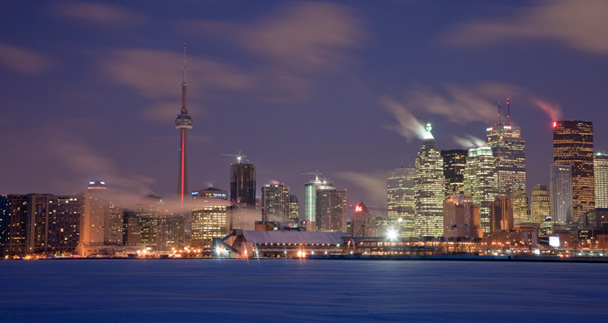There’s a place called Foxley Bistro (416-534-8520), where I send hungry out-of-towners. It’s on the edge of an Azorean neighborhood, up the street from the old Cuban cigar factory and the booming hipster cocktail bars (and, by the way, Rua Vang Golden Turtle, a Vietnamese place with killer pho). At Foxley you walk through the doorway into a long, busy, simple-looking space, where owner Tom Thai, a soft-speaking chef who grew up in Vietnam and fled with his family to Canada in 1978, will greet you if you’re lucky and he’s not in the kitchen. Thai started out as a sushi chef, but he always seemed to think more broadly than that.
At Foxley, Thai does ceviche made from sweet, opalescent strips of Arctic char from northern Canada, dressed with puckery green apple matchsticks, ginger slivers, and a blast of roasted chiles for heat. He blends poblano peppers with Szechuan ones, and stuffs light-as-air dumplings with lamb and duck prosciutto. The menu is Southeast Asian, because that’s where Thai comes from, but it’s also Chinese and South and Central American and Korean and French, and his pork buns taste a little like Jewish brisket spicing, since that’s what he bases his brine on (and the food is also excellent and thoughtful; it works because Thai is a fantastic cook). The crowd most nights is as promiscuously polycultural as the cooking is. Foxley is a pretty typically Torontonian place.
Toronto, more than nearly any other place on earth, is a city of immigrants. Though the metropolis’ history is largely white, Anglican—and stodgy, if we’re totally honest about it—today nearly half its 5 million residents are foreign-born. Like Tom Thai, a lot of them can’t help absorbing their new surroundings. But what makes Toronto such an exciting dining city is that the city always absorbs a little back.
A few blocks south and west through town, a young, impeccably trained chef named Aaron Joseph Bear Robe opened a terrific restaurant this summer called Keriwa Cafe (416-533-2552), where he’s balancing high-French technique with aboriginal Canadian ingredients. You can find a sublime bison tail and Saskatoon berry pemmican (a traditional native dish of pulverized meat, fat, and berries) with golden, fried bannock (it’s a spin on native flatbread) there, right next to the peach pie and the roasted corn and red pepper soup. Out on Church Street, there’s Guu (416-977-0999), the raucous Japanese izakaya (it’s like a tavern, but with amazing food), with its shouting, long-haired, twentysomething cooks who swing enormous knives and wear bandannas, like child pirate geniuses. You have to go to Gandhi Cuisine (416-504-8155), too, where chef Avtar Singh sells West Indian-style wrap rotis, but stuffed with fiery butter chicken.
And you probably shouldn’t miss Acadia (416-792-6002), the casual, buzzy room that opened in July with a 28-year-old rising star named Matt Blondin at its stove. Blondin, who trained as a fine dining chef, has taken on the tastes and ingredients of the Acadian migration, which spans the Atlantic coast from Canada’s Maritime Provinces right down to Louisiana. He’s melded contemporary Cajun—the étoufées and boudin balls and chow-chow relishes—with a bit of his French-Canadian heritage, and brilliantly, too, and then married all that somehow with the shrimp-and-grits soul of South Carolina and Georgia’s Low Country cuisine. What’s that taste like? Like the green tomato tart that’s built up from buttery puff pastry slicked with fire-roasted, fermented black garlic-goosed cornmeal, and then stacked with whole, oven-warmed tomatoes that have been peeled so that they’re sweet and sour and nearly translucent. They all but quiver when you touch them with a fork. Blondin puts a bit of licorice-y chervil over top, dusts it all with almond-praline powder, and then pipes a bolt of celeriac puree on the plate. It’s one of the greatest dishes in the city right now. But the city’s swelling and changing, always. Toronto gets a new best dish nearly every other week.
Take a short trip up Yonge Street, the former fur-trading route that starts at Lake Ontario, at the base of downtown, and stretches nearly 1,200 miles northwest to the edge of the tundra. After a few minutes’ subway ride north, downtown gives way to kebab shops and hookah lounges interspersed with micro-specialist Korean places that serve only seafood pancakes, or hand-cut noodles, or bacon-style grilled pork belly, or ginseng chicken stew. The city’s food types are obsessed with Korean cuisine these days. David Chang, another chef who knows a thing about adapting disparate ideas and cuisines into something new, has announced he’ll open two Momofuku restaurants in town next year.
Or head to Sun’s Kitchen (905-947-8463), which serves La Mian (a type of hand-pulled noodle) in the Pacific Mall, in Markham, the suburb where more than half the population comes from China. Or up to Ming Room (905-812-1234), in the suburb of Mississauga, for “Calcutta-Chinese” Hakka-style food, like Manchurian paneer, a blend of Indian cheese and coriander in a chile-spiked, soy-based sauce. Or if you’re not that adventuresome, you should head to Cafe Belong (416-901-8234), a new market-driven bistro close to downtown (try the gently smoked, sliced, ruby-toned duck breast topped with sour cherries) that overlooks the Don Valley Brick Works, a Victorian-era quarry and industrial complex that’s been transformed into a verdant nature area. (The Saturday farmers' market at the Brickworks is one of the city’s best.)



 Pinterest
Pinterest


